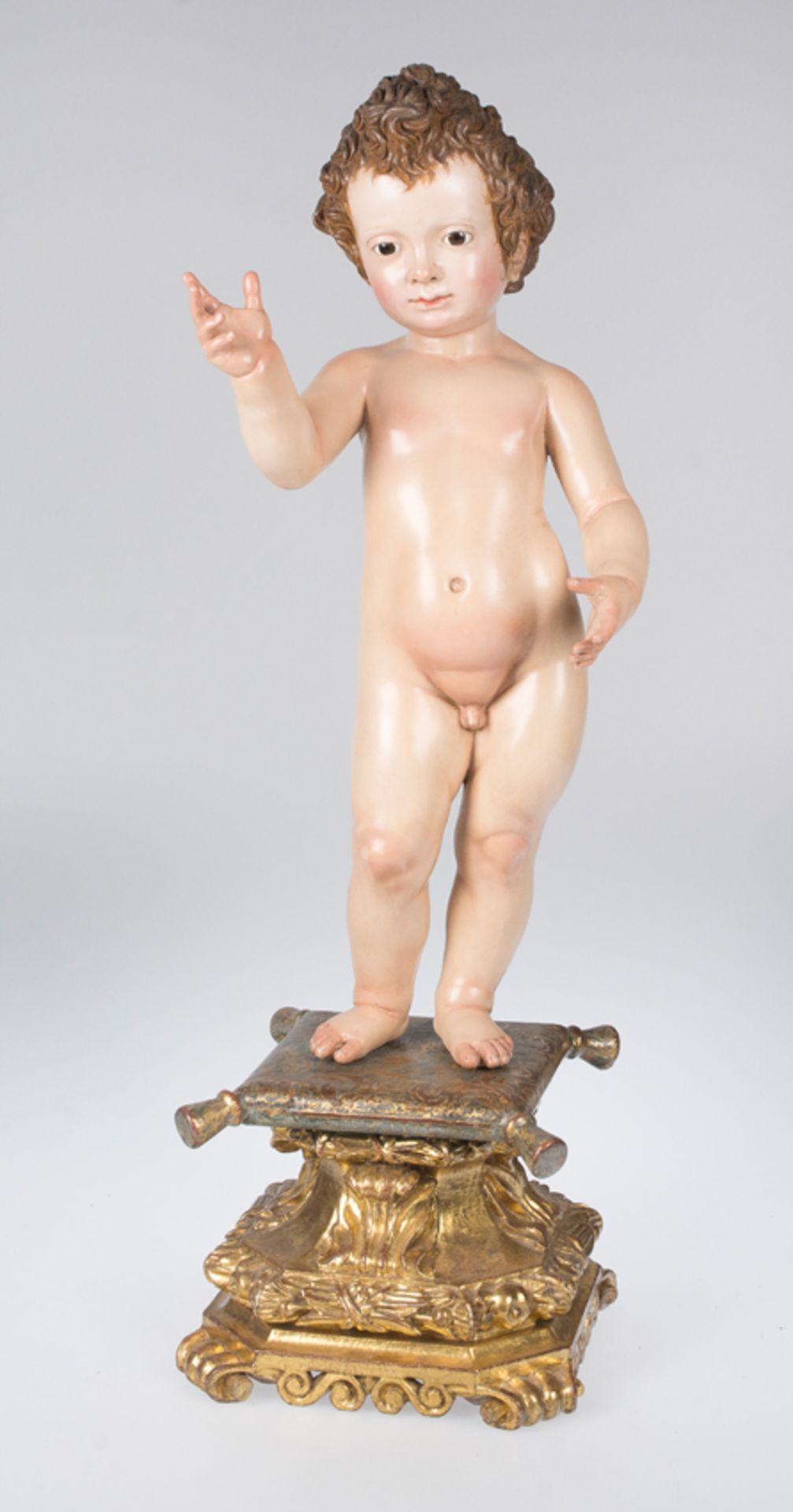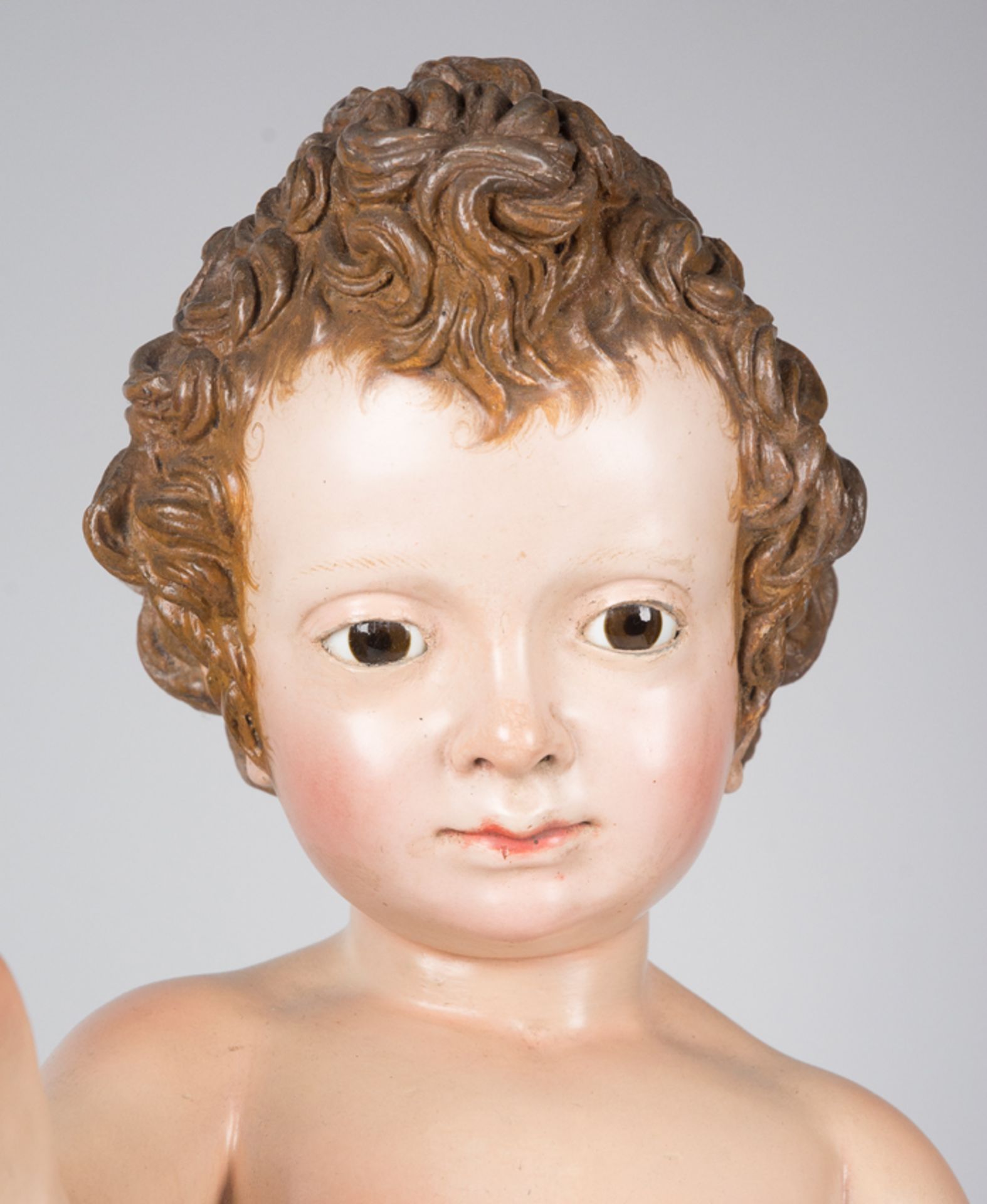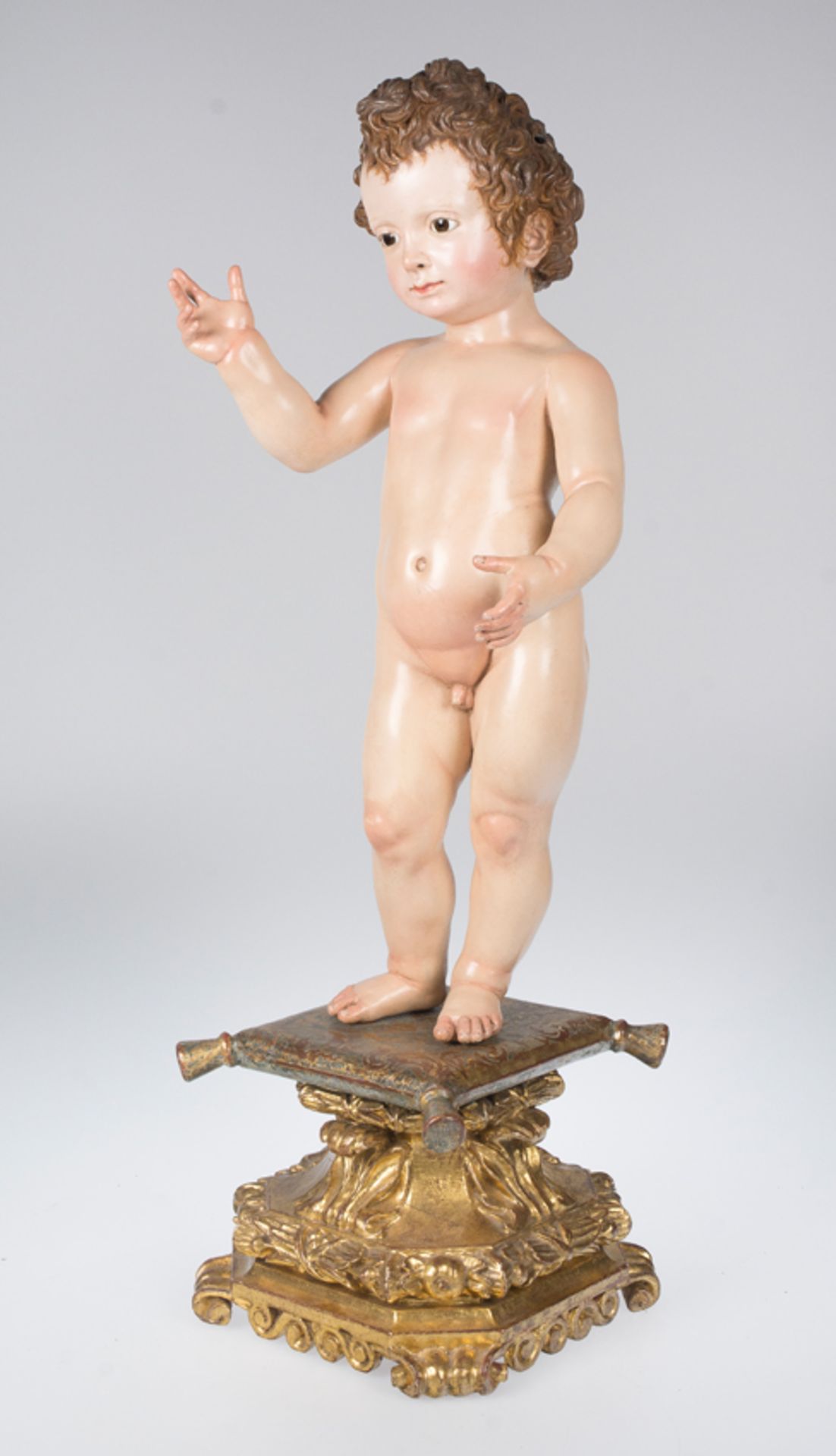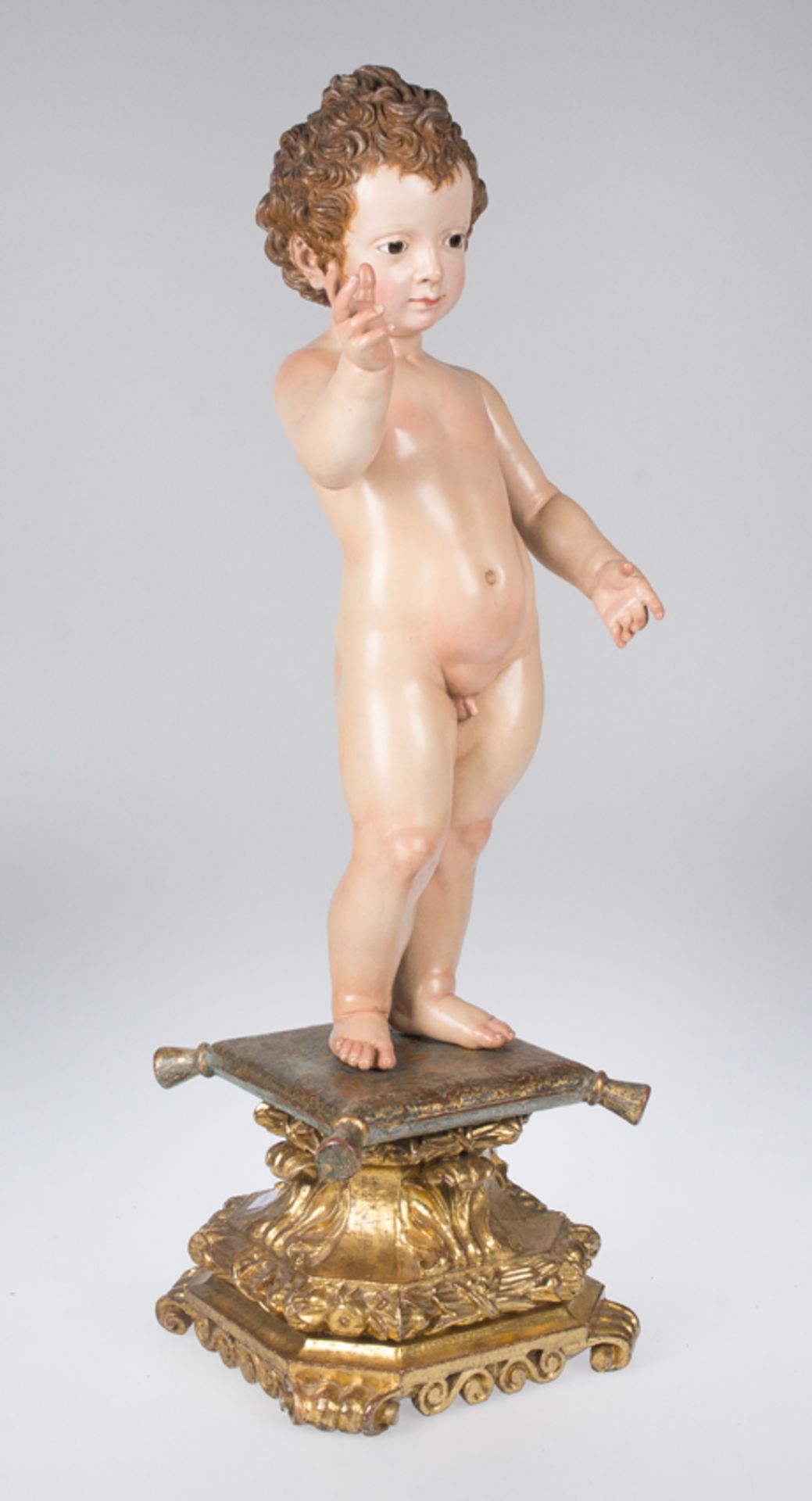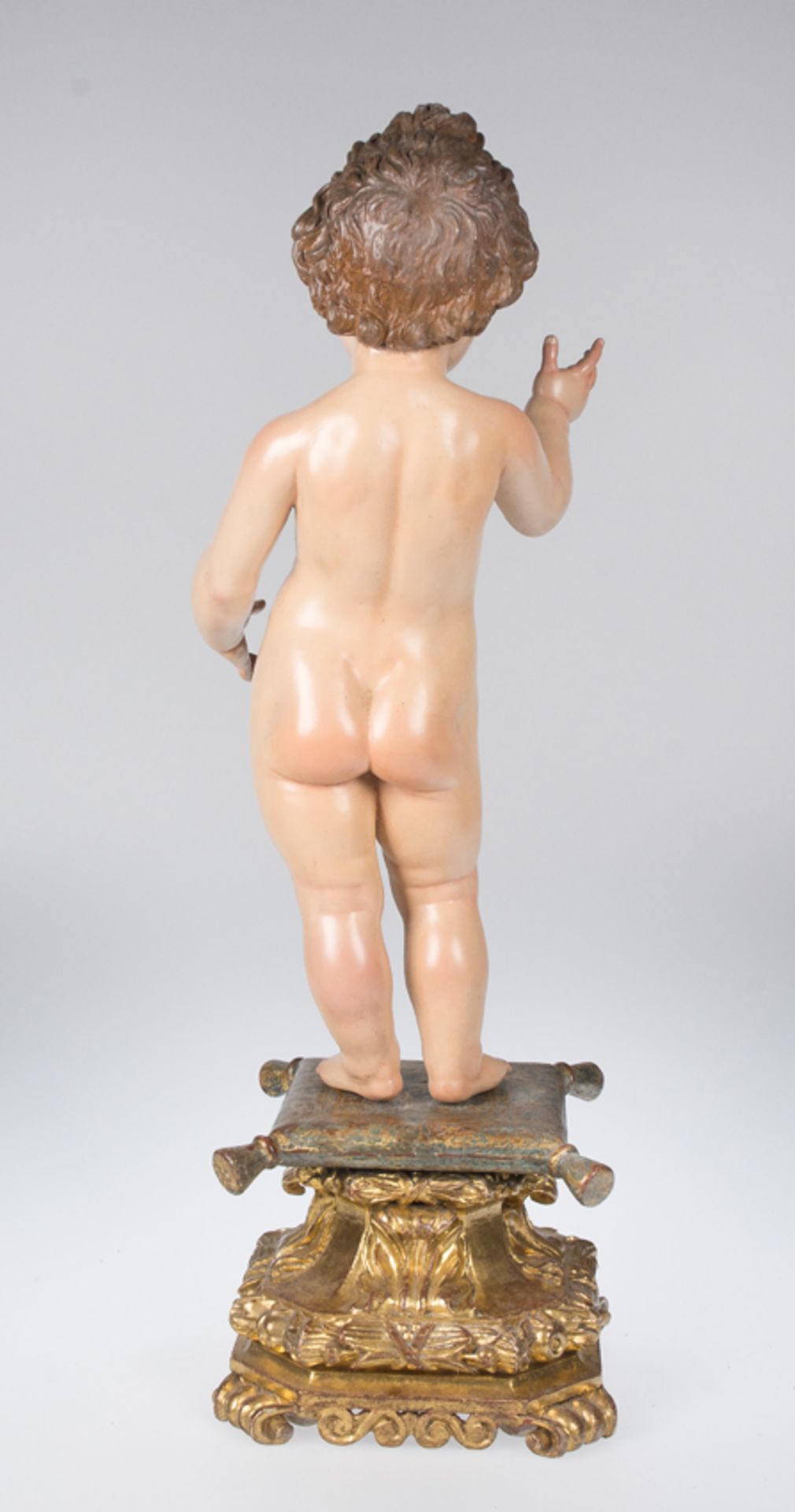28
"Blessing Christ Child". Anonymous from Seville. First third of the 17th century
"Blessing Christ Child". Anonymous from Seville. First third of the 17th century
Polychromed lead sculpture.
71 x 22 x 22 cm.
The Christ Child that we present is taken from the famous Christ Child made by Juan Martínez Montañés (1568-1649), who in turn seems to have been inspired by engravings by Albrecht Dürer (1471-1528) and Martín de Vos (1532-1603). Indeed, on August 30, 1606, the "God of wood" had agreed with Pedro de Cuenca, administrator of the Sacramental Brotherhood of the Tabernacle of Seville, to sculpt a triumphant Christ Child "of the size that fits a silver litter that The Brotherhood has that will be a little more or less than a yard… of cedar wood from Havana planted in a receptacle that comes out of the length of the wood and planted in a borne wood urn”. It was completed on February 2, 1607, for which the artist received 1,300 reales. The painter Gaspar de Raxis then took over the polychroming of it.
The model by Montañés, which was continued by his disciple Juan de Mesa (1583-1627), and by many other Sevillian and Andalusian sculptors (the Ribas family, Alonso Cano (1601-1667), etc.), was enormously successful, leading to mass production both in wood as well as in metal, especially in pewter, so that we can find countless copies throughout Spain and Latin America.
Professor Hernández Díaz pointed out that “the marvellous Child Jesus of the Sacramental of the Tabernacle, is one of the most joyous depictions of the theme in Spanish art, where the master attempts and manages to highlight the supernatural. In this brilliant version, Montañés was able to combine the charm of infancy with the majestic presence of God the Redeemer”, and with “this image he reached the peak of the representation of the theme, by showing the deified theological depth with singular theodicy, offering a statue of enormous tenderness and great attractiveness that magnetizes the viewer”
This marvellous specimen is one of those Christ Children which is executed in polychromed lead and is impressive both for its splendid quality and for its fantastic state of preservation. The figure stands on a cushion with golden tassels at the ends that sits on a plinth decorated with fallen leaves and scrolls made of vegetation. The Divine Infant is naked, although he could well have been dressed, showing a stylized anatomy, but with noticeable muscles and joints. The arms appear slightly separated from the torso, at 45º angles. Thus, with his right hand he prepares to bless while with his left it seems that he was holding some element – the original Child Jesus by Montañés first had a cross and later, in 1629, the artist Pablo Legot changed his hands for others made of lead to then hold a chalice in order to echo the Eucharistic allegory–. His head, which shows a face that mixes seriousness and melancholy, has expressive almond-shaped eyes, a small nose, and a closed mouth with thin lips. He has a prominent head of hair composed of countless curls that create chiaroscuro effects, highlighting the central tuft that is a typical characteristic of Montañés’ creations, and therefore of all the copies of these models.
The differences in the style, specifically from the famous example by Montañés, are absolutely clear. For example, the anatomy suggests a certain stiffness, the left hand is held low and the legs, instead of being separate, are held almost together, making a slight counterpose which is perceptible in the wrinkles that are formed at the left knee.
We must point out the extremely beautiful face, which leans to watch the worshippers which he blesses, as well as the very meticulously worked hair which is splendidly trepanned, capturing each of the infinite curls of which the hair is composed.
We would like to thank Javier Baladrón, doctor in History of Art, for cataloguing this piece.
"Blessing Christ Child". Anonymous from Seville. First third of the 17th century
Polychromed lead sculpture.
71 x 22 x 22 cm.
The Christ Child that we present is taken from the famous Christ Child made by Juan Martínez Montañés (1568-1649), who in turn seems to have been inspired by engravings by Albrecht Dürer (1471-1528) and Martín de Vos (1532-1603). Indeed, on August 30, 1606, the "God of wood" had agreed with Pedro de Cuenca, administrator of the Sacramental Brotherhood of the Tabernacle of Seville, to sculpt a triumphant Christ Child "of the size that fits a silver litter that The Brotherhood has that will be a little more or less than a yard… of cedar wood from Havana planted in a receptacle that comes out of the length of the wood and planted in a borne wood urn”. It was completed on February 2, 1607, for which the artist received 1,300 reales. The painter Gaspar de Raxis then took over the polychroming of it.
The model by Montañés, which was continued by his disciple Juan de Mesa (1583-1627), and by many other Sevillian and Andalusian sculptors (the Ribas family, Alonso Cano (1601-1667), etc.), was enormously successful, leading to mass production both in wood as well as in metal, especially in pewter, so that we can find countless copies throughout Spain and Latin America.
Professor Hernández Díaz pointed out that “the marvellous Child Jesus of the Sacramental of the Tabernacle, is one of the most joyous depictions of the theme in Spanish art, where the master attempts and manages to highlight the supernatural. In this brilliant version, Montañés was able to combine the charm of infancy with the majestic presence of God the Redeemer”, and with “this image he reached the peak of the representation of the theme, by showing the deified theological depth with singular theodicy, offering a statue of enormous tenderness and great attractiveness that magnetizes the viewer”
This marvellous specimen is one of those Christ Children which is executed in polychromed lead and is impressive both for its splendid quality and for its fantastic state of preservation. The figure stands on a cushion with golden tassels at the ends that sits on a plinth decorated with fallen leaves and scrolls made of vegetation. The Divine Infant is naked, although he could well have been dressed, showing a stylized anatomy, but with noticeable muscles and joints. The arms appear slightly separated from the torso, at 45º angles. Thus, with his right hand he prepares to bless while with his left it seems that he was holding some element – the original Child Jesus by Montañés first had a cross and later, in 1629, the artist Pablo Legot changed his hands for others made of lead to then hold a chalice in order to echo the Eucharistic allegory–. His head, which shows a face that mixes seriousness and melancholy, has expressive almond-shaped eyes, a small nose, and a closed mouth with thin lips. He has a prominent head of hair composed of countless curls that create chiaroscuro effects, highlighting the central tuft that is a typical characteristic of Montañés’ creations, and therefore of all the copies of these models.
The differences in the style, specifically from the famous example by Montañés, are absolutely clear. For example, the anatomy suggests a certain stiffness, the left hand is held low and the legs, instead of being separate, are held almost together, making a slight counterpose which is perceptible in the wrinkles that are formed at the left knee.
We must point out the extremely beautiful face, which leans to watch the worshippers which he blesses, as well as the very meticulously worked hair which is splendidly trepanned, capturing each of the infinite curls of which the hair is composed.
We would like to thank Javier Baladrón, doctor in History of Art, for cataloguing this piece.
"On Prophets, Saints and Princesses"
Sale Date(s)
Venue Address
General delivery information available from the auctioneer
The purchase price includes the delivery of the lots in the venue of the auction. Transporting to other destinations is at the own risk of the client. The customer must contact "LST", to give the corresponding instructions for such transporting. "LST" is not responsible for the packaging or any accident incurred during transportation.
Important Information
Aufgeld / Premium: 22 %
Live: 3 %
jeweils plus 21 % USt. / each plus 21 % VAT
Terms & Conditions
CONDITIONS OF THE AUCTION:
I. REGISTRATION. To bid in the room customers must register at the beginning, filling out a form and picking a number that will identify them during the auction. Customers may be required to register in bank references or other guarantee system and if they do not prove the solvency "LST" will not accept bids and award the auction.
II. WRITTEN BIDS. "LST" will accept written bids, which will be formalized in the form provided by the room until the day before the auction. In such auctions, the room will bid in name of the client until the maximum stated in the offer and always at the lowest possible price. If there are two or more bids for the same amount, the one placed first will have the priority. Written bids received in advance, will have priority on the day of the auction.
III. TELEPHONE BIDS. "LST" will allow telephone bids, if interested people contact "LST" days before the auction providing personal data, ID card and the phone number which will be used by the staff of "LST" to call at the time of the auction. The buyer, within all the legal rights is making an offer for the asking price, when applies for telephone bid. "LST" will not take responsibility for any technical defects beyond its control, which may prevent to contact successfully the bidder during the auction.
IV. AUCTIONEER. The auction will be conducted by an auctioneer, director of the auction will be judge and arbitrator of it with full authority in its development, will award the lots to the highest bidder and is able to settle any controversy concerning lots sale, reject bids, divide lots or group them and remover objects from the room. Will be able to, if it is deemed suitable, not accept bids on the auction. His decision will be unappealable.
V. SALE OF LOTS. The lots are awarded to the highest bidder. Once the auctioneer blows the hammer, the buyer becomes responsible of the lot purchased, exempting "LST" of liability to for any damage and / or accidents that may occur. No refunds of lots.
VI. STARTING PRICE. The amount shown in the catalogue as the starting price for each lot will be, as a rule, the minimum selling price, except for exceptional cases where a reservation may be agreed upon with the seller or it set discretionary by the room.
VII. SCALE OF BIDS. The bids are set according to the following scale:
From 50.-€ to 200.-€…………………………………………..at 10.-€
From 200.-€ to 500.-€…………………………………… …25 in 25.-€
From 500.-€ to 1.000.-€………………………………..…..….50 in 50.-€
From 1.000.-€ to 2.000.-€………………………………..…100 in 100.-€
From 2.000.-€ to 5.000.-€……………………………….….250 in 250.-€
From 5.000.-€ to 10.000.-€…………………………………500 in 500.-€
From 10.000.-€ to 20.000.-€……………………………1.000 in 1.000.-€
From 20.000.-€ to 50.000.-€……………………………2.500 in 2.500.-€
From 50.000.-€ to 100.000.-€…………………………..5.000 in 5.000.-€
From 100.000.-€ to 100.000.-€………………………10.000 in 10.000.-€
From 200.000.-€ to 200.000.-€………………………25.000 in 25.000.-€
From 500.000.-€ to 500.000.-€………………………50.000 in 50.000.-€
VIII. RIGHT OF ADMISION. "LST" reserves the right to admission to the auction room and to reject, at its judgment, any purchase order, from clients whose solvency is not duly proved as well as not to sale auctions.
IX. SALE PRICES. The successful bidder of one or more lots must pay "LST" the final sale price achieves at auction, plus the 22 % plus 21% VAT on the commission, at total 26,62 % on Hammer Price.
X. CATALOG DATA. The catalogue data are obtained in order to careful research and advice, however, any responsibility is afforded about its accuracy. The lots will be auctioned in the state in which they are, not accepting any claims in restorations, breakage, damage, imperfections and, even description or numbering mistakes in the catalogue, in case of it, being the burden of the buyers to make sure before the auction that the description matches with their personal opinion about respective lot. The exhibition of the lots is intended to allow a perfect review and study of them.
XI. PAYMENT AND REMOVAL OF LOTS. Payment and removal of the lots will be held no later than five days following the auction. After this period expire without having the buyer removed the lot or lots purchases, it will accrue an expense of custody of 6 euros per day on each lot.
15 days after the auction without having the buyer paid and removes the sold lots, "LST" will inform the seller and there will begin judicial proceeding in order to obtain payment. The delay in payment by the purchaser of his/her sold lots will carry an interest increase at a rate of 1,5% per month.
XII. DELIVERY OF LOTS. The purchase price includes the delivery of the lots in the venue of the auction. Transporting to other destinations is at the own risk of the client. The customer must contact "LST", to give the corresponding instructions for such transporting. "LST" is not responsible for the packaging or any accident incurred during transportation.
XIII. RIGHT OF FIRT REFUSAL AND REPURCHASE. "LST" in order to article 38 of "Ley 16/1985 de 25 Junio del Patrimonio Histórico Español" (BOE. 155 June 29, 1985), will notify in advance to the Ministry of Culture, the content of their catalogues. Concerning the lots subject to the legislation referred to in the preceding paragraph, the Administration may exercise the rights of first refusal and repurchase according to the law. "LST" will watch over the protection of Artistic, Historical and Bibliographical Heritage of Spain. For customers out of European Community, a tax for export is required by the Administration.
XIV. VALUE ADDED TAX (I.V.A). This tax will be accrued on commissions of "LST" for buyers, using the rates prevailing on the date of the auction.
XV. DATA PROTECTION. In order to the "Ley 15/1999 de 13 de Diciembre, de Protección de Datos de Carácter Personal", the client authorize "LST", the inclusion of their data in a customer file, and for the promotion by "LST" of the objects at all times the rights of access, rectification or deletion of personal data by sending the appropriate request to the following address: LA SUITE SUBASTAS, C/ Conde Salvatierra, 8, 08006. Barcelona.
XVI. EXPRESS LEGAL JURISDICTION. These Conditions are governed by and interpreted in accordance with the rules of Spanish law. The mere act of participating in the auction as seller, buyer or bidder, implies acceptance of these Terms and Conditions.
Sales operations are understood to be held at the registered office of "LST", C/ Conde de Salvatierra, 8, 08006. Any dispute shall be taken to the competent courts of Barcelona, expressly waiving any other jurisdiction, in accordance with Article 55 of the "Ley de Enjuiciamiento Civil".












